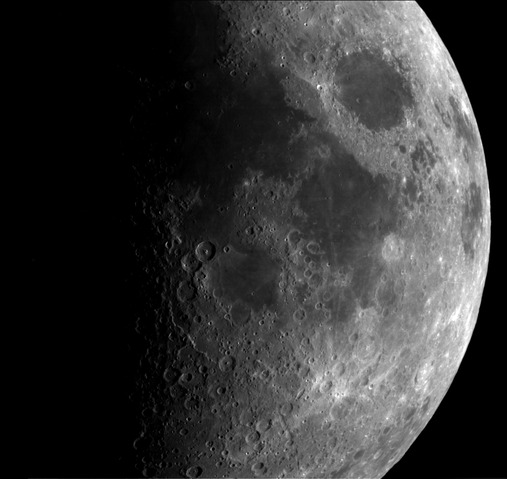 |
This is a file from the Wikimedia Commons. Information from its description page there is shown below.
Commons is a freely licensed media file repository. You can help.
|
Summary
| DescriptionMoon seen by Cassini - PIA02321.tif |
English: This narrow angle image taken by Cassini's camera system of the Moon is one of the best of a sequence of narrow angle frames taken as the spacecraft passed by the Moon on the way to its closest approach with Earth on August 17, 1999. The 80 millisecond exposure was taken through a spectral filter centered at 0.33 microns; the filter bandpass was 85 Angstroms wide. The spatial scale of the image is about 1.4 miles per pixel (about 2.3 kilometers). The imaging data were processed and released by the Cassini Imaging Central Laboratory for Operations (CICLOPS) at the University of Arizona's Lunar and Planetary Laboratory, Tucson, AZ.
|
| Date |
17 August 1999 |
| Source |
http://photojournal.jpl.nasa.gov/catalog/PIA02321 |
| Author |
NASA/JPL/Space Science Institute |
Licensing
| Public domainPublic domainfalsefalse |
 |
This file is in the public domain because it was solely created by NASA. NASA copyright policy states that "NASA material is not protected by copyright unless noted". (See Template:PD-USGov, NASA copyright policy page or JPL Image Use Policy.) |
|
|
|
Warnings:
- Use of NASA logos, insignia and emblems are restricted per US law 14 CFR 1221.
- The NASA website hosts a large number of images from the Soviet/ Russian space agency, and other non-American space agencies. These are not necessarily in the public domain.
- Materials based on Hubble Space Telescope data may be copyrighted if they are not explicitly produced by the STScI. See also {{ PD-Hubble}} and {{ Cc-Hubble}}.
- The SOHO (ESA & NASA) joint project implies that all materials created by its probe are copyrighted and require permission for commercial non-educational use.
- Images featured on the Astronomy Picture of the Day (APOD) web site may be copyrighted.
|
This file contains additional information, probably added from the digital camera or scanner used to create or digitize it. If the file has been modified from its original state, some details may not fully reflect the modified file.
SOS Children chose the best bits of Wikipedia to help you learn. SOS Children helps those who have nothing and no one, giving them back the famly they have lost and bringing them the very best opportunities for a happy, healthy future. You can help by sponsoring a child.





